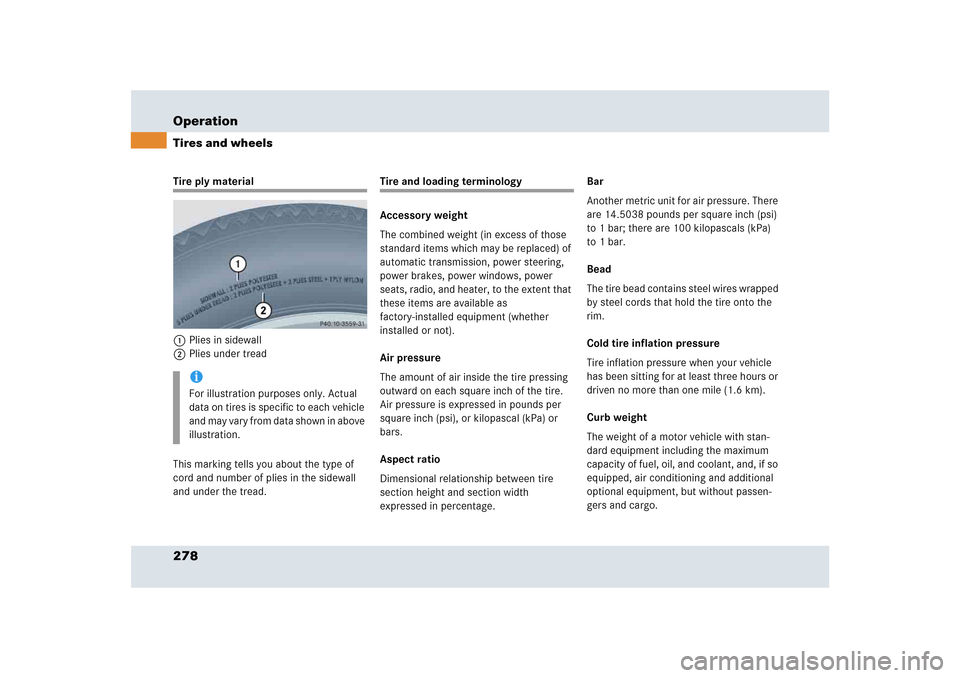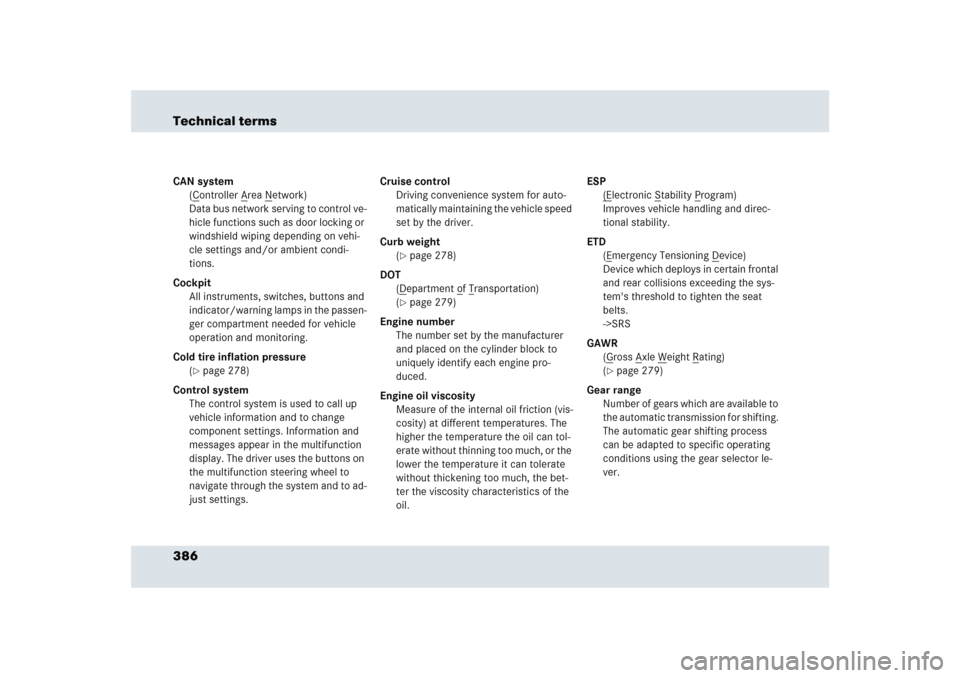Page 279 of 417

278 OperationTires and wheelsTire ply material
1Plies in sidewall
2Plies under tread
This marking tells you about the type of
cord and number of plies in the sidewall
and under the tread.
Tire and loading terminology
Accessory weight
The combined weight (in excess of those
standard items which may be replaced) of
automatic transmission, power steering,
power brakes, power windows, power
seats, radio, and heater, to the extent that
these items are available as
factory-installed equipment (whether
installed or not).
Air pressure
The amount of air inside the tire pressing
outward on each square inch of the tire.
Air pressure is expressed in pounds per
square inch (psi), or kilopascal (kPa) or
bars.
Aspect ratio
Dimensional relationship between tire
section height and section width
expressed in percentage.Bar
Another metric unit for air pressure. There
are 14.5038 pounds per square inch (psi)
to 1 bar; there are 100 kilopascals (kPa)
to 1 bar.
Bead
The tire bead contains steel wires wrapped
by steel cords that hold the tire onto the
rim.
Cold tire inflation pressure
Tire inflation pressure when your vehicle
has been sitting for at least three hours or
driven no more than one mile (1.6 km).
Curb weight
The weight of a motor vehicle with stan-
dard equipment including the maximum
capacity of fuel, oil, and coolant, and, if so
equipped, air conditioning and additional
optional equipment, but without passen-
gers and cargo.
iFor illustration purposes only. Actual
data on tires is specific to each vehicle
and may vary from data shown in above
illustration.
Page 298 of 417
297 Practical hints
What to do if ...
Problem
Possible cause
Suggested solutions
-
The yellow ABS indicator
lamp comes on while driving.
The ABS has detected a malfunction and
has switched off. The BAS and the ESP are
also switched off (see messages in dis-
play).
The SBC brake system is still functioning
normally but without ABS available.
If the ABS control unit is malfunctioning
the automatic transmission may also be
malfunctioning.
�
Continue driving with added caution. Wheels
may lock during hard braking, reducing
steering capability.
�
Read and observe messages in the display
(�page 304).
�
Have the system checked at an authorized
Mercedes-Benz Center immediately.
Failure to follow these instructions increases
the risk of an accident.
The charging voltage has fallen below
10 volts and the ABS was switched off.
When the voltage is above this value again, the
ABS is operational again.�
If necessary, have the generator and battery
checked.
Page 309 of 417
308 Practical hintsWhat to do if ...Left display
Right display
Possible cause
Possible solution
ESP
Display malfunc-
tion
Visit
workshop!
The ESP or the ESP display is
malfunctioning.
�
Continue driving with added caution.
�
Have the system checked at an authorized
Mercedes-Benz Center immediately.
Failure to follow these instructions increases the risk of an
accident.
SLR
ACL system
malfunction
Visit
workshop!
�
The locking system is
malfunctioning.
�
The transmission cooling
system is malfunctioning.
�
Have the system checked at an authorized
Mercedes-Benz Center immediately.
Page 358 of 417

357 Practical hints
Towing the vehicle
�Towing the vehicle
Mercedes-Benz recommends that the vehi-
cle be transported with all wheels off the
ground using flatbed or appropriate wheel
lift/dolly equipment.
When circumstances do not permit the
recommended towing methods, the vehi-
cle may be towed with all wheels on the
ground or front wheels raised only so far as necessary to have the vehicle moved to a
safe location where the recommended
towing methods can be employed.
!Use flatbed or wheel lift/dolly equip-
ment with SmartKey in starter switch
turned to position0.
Do not tow with sling-type equipment.
Towing with sling-type equipment over
bumpy roads will damage radiator and
supports.
To prevent damage during transport,
do not tie down vehicle by its chassis or
suspension parts.
Switch off the tow-away alarm and the
automatic central locking.
!If the vehicle is towed with the front
axle raised, the engine must be shut off
(SmartKey in starter switch position0
or1). Otherwise the ESP will immedi-
ately be engaged and will apply the rear
wheel brakes.
When towing the vehicle with all wheels
on the ground, the gear selector lever
must be in positionN and the
SmartKey must be in starter switch
position2.
When towing the vehicle with all wheels
on the ground or the front axle raised,
the vehicle may be towed only for dis-
tances up to 30 miles (50 km) and at a
speed not to exceed 30 mph
(50 km/h).
!To be certain to avoid a possibility of
damage to the transmission, however,
we recommend the drive shaft be dis-
connected at the rear axle drive flange
for any towing beyond a short tow to a
nearby garage.
Page 361 of 417
360 Practical hintsTowing the vehiclePoints to bear in mind�
The vehicle must not be tow-started.
�
If the vehicle is to be towed, only tow it
with all wheels on the ground.
�
If the vehicle has suffered transmission
damage, only tow it with the propeller
shaft disconnected.
�
Before towing the vehicle, make sure
the battery is connected and charged.
Otherwise you will not be able to switch
on the ignition and move the selector
lever to N. There will then be no power
assistance when steering and braking.
Transporting the vehicle
The towing eye bolt can be used to pull the
vehicle onto a trailer or transporter for
transporting purposes.�
Move the selector lever to N.!Due to the low clearance height of the
SLR, care must be taken when loading
and unloading from a transporter to
avoid damaging the vehicle body work.
To secure the vehicle, only tie it down
by the wheels or tires. Otherwise it
could be damaged.
Page 376 of 417
375 Technical data
Fuels, coolants, lubricants, etc.
�Fuels, coolants, lubricants, etc.
CapacitiesVehicle components and their respective
lubricants must match. Therefore use only
products tested and approved by
Mercedes-Benz. Please refer to the Factory Approved
Service Products pamphlet, or inquire at
your Mercedes-Benz Center.
Capacity
Fuels, coolants, lubricants, etc.
Engine with oil filter
9.5 US qt (9.0 l)
Approved engine oils
Automatic transmission
9.1 US qt (8.6 l)
MB Automatic Transmission Fluid
Rear axle
1.9 US qt (1.8 l)
Hypoid gear oil SAE 75 W 85
Power steering
approximately 1.15 US qt (1.1 l)
MB Power Steering Fluid (Pentosin CHF 11S)
Front wheel hubs
approximately 3.0 oz (85 g) each
High temperature roller bearing grease
Brake system
1.6 US qt (1.5 l)
MB Brake Fluid (DOT 4+)
Page 387 of 417

386 Technical termsCAN system
(C
ontroller A
rea N
etwork)
Data bus network serving to control ve-
hicle functions such as door locking or
windshield wiping depending on vehi-
cle settings and/or ambient condi-
tions.
Cockpit
All instruments, switches, buttons and
indicator/warning lamps in the passen-
ger compartment needed for vehicle
operation and monitoring.
Cold tire inflation pressure
(
�page 278)
Control system
The control system is used to call up
vehicle information and to change
component settings. Information and
messages appear in the multifunction
display. The driver uses the buttons on
the multifunction steering wheel to
navigate through the system and to ad-
just settings.Cruise control
Driving convenience system for auto-
matically maintaining the vehicle speed
set by the driver.
Curb weight
(
�page 278)
DOT
(Department o
f Transportation)
(
�page 279)
Engine number
The number set by the manufacturer
and placed on the cylinder block to
uniquely identify each engine pro-
duced.
Engine oil viscosity
Measure of the internal oil friction (vis-
cosity) at different temperatures. The
higher the temperature the oil can tol-
erate without thinning too much, or the
lower the temperature it can tolerate
without thickening too much, the bet-
ter the viscosity characteristics of the
oil.ESP
(E
lectronic S
tability P
rogram)
Improves vehicle handling and direc-
tional stability.
ETD
(E
mergency Tensioning D
evice)
Device which deploys in certain frontal
and rear collisions exceeding the sys-
tem's threshold to tighten the seat
belts.
->SRS
GAWR
(G
ross A
xle W
eight R
ating)
(
�page 279)
Gear range
Number of gears which are available to
the automatic transmission for shifting.
The automatic gear shifting process
can be adapted to specific operating
conditions using the gear selector le-
ver.
Page 389 of 417

388 Technical termsOverspeed range
Engine speeds within the red marking
on the tachometer dial. Avoid this en-
gine speed range, as it may result in se-
rious engine damage that is not
covered by the Mercedes-Benz Limited
Warranty.
Poly-V-belt drive
Drives engine-components (alternator,
AC compressor, etc.) from the engine.
Power train
Collective term designating all compo-
nents used to generate and transmit
motive power to the drive axles, includ-
ing
�
engine
�
clutch/torque converter
�
transmission
�
transfer case
�
drive shaft
�
differential
�
axle shafts/axlesProduction options weight
(
�page 279)
Program mode selector switch
Used to switch the automatic transmis-
sion between sport operation (S), com-
fort operation (C) and manual
operation (MAN).
PSI
(Pounds per s
quare i
nch)
(
�page 280)
Recommended tire inflation pressure
(�page 280)
REST
(Residual Engine Heat Utilization)
Feature that uses the engine heat
stored in the coolant to heat the vehi-
cle interior for a short time after the en-
gine has been turned off.
Rim
(�page 280)RON
(R
esearch O
ctane N
umber)
The Research Octane Number for gaso-
line as determined by a standardized
method. It is an indication of a gaso-
line's ability to resist undesired detona-
tion (knocking). The average of both
the MON (Motor Octane Number) and
RON (Research Octane Number) is
posted at the pump, also known as
ANTI-KNOCK INDEX.
SBC brake system
(S
ensotronic B
rake C
ontrol)
Electronically controlled hydraulic
braking system for increased braking
safety and comfort.
Shift lock
When the vehicle is parked, this lock
prevents the gear selector lever from
being inadvertently moved out of posi-
tion P without SmartKey turned and
brake pedal depressed.